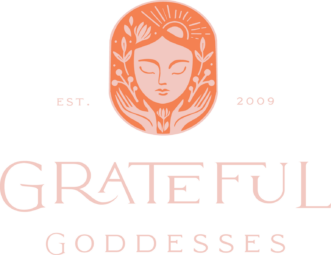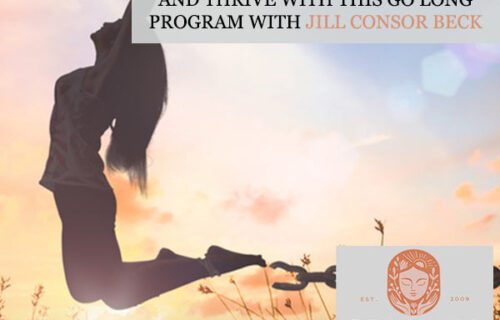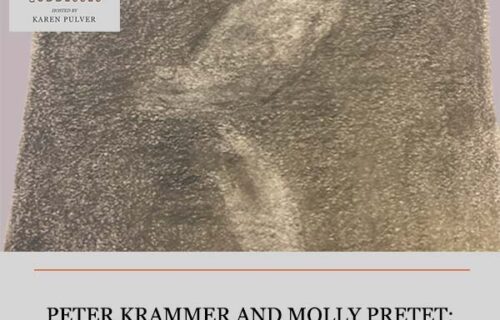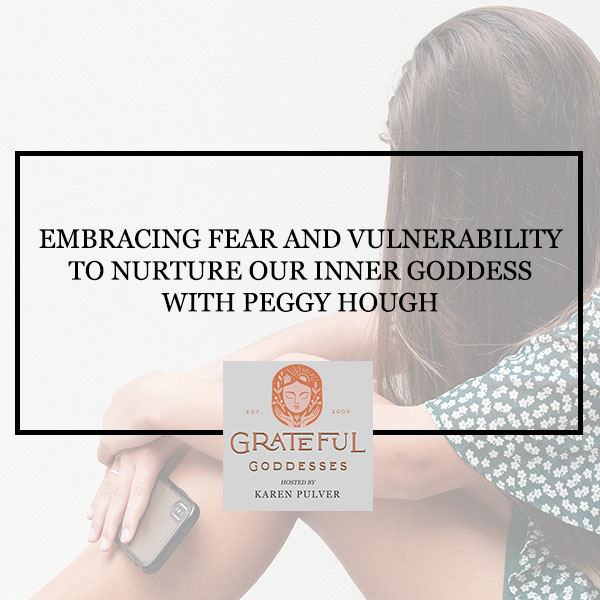
Embracing Fear And Vulnerability To Nurture Our Inner Goddess With Peggy Hough
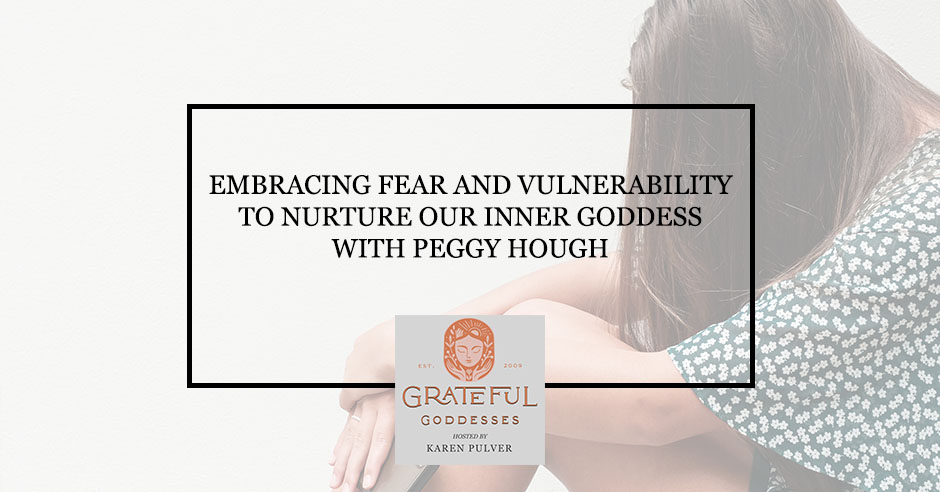
“You always had the courage inside!” This is what the Wizard of Oz reminded the Cowardly Lion when he was given the medal of courage he was greatly seeking. In the same way, we all have fears, anxieties, and vulnerabilities. Yet, we are often afraid to feel and talk about them, and may not know how best to handle them to take care of ourselves and our well-being. In this episode, Karen Pulver is joined by Psychotherapist Peggy Hough to discuss the fears and vulnerabilities we have, especially with the current situation in our society. What are the ways we can hold this fear close and experience it instead of stuffing it down or ignoring it? Together with the featured goddesses, follow this journey to learn how we can embrace those fears and nurture our Inner Goddess in the process.
—
Watch the episode here
Listen to the podcast here
Embracing Fear And Vulnerability To Nurture Our Inner Goddess With Peggy Hough
“There Is No Such Thing As Failure, It Is All Just Feedback” – Peggy Hough
I’d like to start off with a quote. “Perhaps strength doesn’t reside in never having been broken, but in the courage required to grow strong in the broken places.” What is this courage? For me, when I think about courage, I always think about the Lion in The Wizard of Oz and how he struggled to get courage and how he thought that The Wizard would give him courage. In the end, he had the courage in him all along. I believe as goddesses, we have that inner goddess courage inside us all along, but how do we get there? How do we discover this courage? We all have fears, anxieties, vulnerabilities, and we need courage to get past those fears, plus a lot of other support.
We’re going to be talking with our guest Peggy Hough, who is a licensed Clinical Professional Counselor for many years. She’s a certified alcohol and other addictions counselor. She specializes in the treatment of addictive disorders and trauma. She’s also an NLP Master’s Level clinician, which is Neuro-Linguistic Programming that is with an approach to communication, personal development and psychotherapy. She’s also a Polyvagal Informed Therapist. With her work, she strives to help others to attain a better understanding of themselves, their goals, and values to develop skills for improving their relationships. Finding resolution to issues or concerns that lead them to seek their therapy. Learning new ways to cope with stress and anxiety. Managing anger, grief, depression, and other emotional pressures among other benefits when you work with Peggy.
For me personally, and this is where I’m going to be vulnerable. I struggled with communication issues with my husband for many years. We had a time where we were not communicating. We were not respecting each other’s wishes or each other’s selves. We went to Peggy and she was remarkable in helping us to understand each other. We fought on our drives home, but from that help with Peggy, she stood there as an objective person in helping us with therapy to get past a lot of things. We still have our fights and issues. I still might go back to her for some tweaking, but I do believe in therapy to help you to become that best goddess that you can be. Welcome, Peggy.
It’s a pleasure to be here and an honor that you thought to even invite me. I appreciate it.
I love your energy and wisdom. Your quote that’s on your website about courage, I thought about that lion and about how he had the courage all along. I was wondering about your thoughts about fears, anxiety, and vulnerability. When I was younger, I was always afraid of the monster under my bed. I’d take that little peak and there was no monster, and then it was okay. As I got older, I was okay with things. Things were manageable but many years ago, I had a cancer diagnosis and my whole world turned upside down. No matter how much I tried subconsciously, I was afraid. I’d have panic attacks.
I’d have anxiety getting into elevators and closed, confined places. I did go to cognitive behavioral therapy. I learned how to take that fear and bring it close to me and hold it. I still struggle every now and then with that feeling of anxiety, especially now with COVID and our political system, the social injustice that’s happening, the looting that’s going on downtown with the protesters. There’s so much happening and I know we’re not here for a session of therapy that you’re going to fix it and one thing. I’d love to know your thoughts about how therapy can help someone like me that’s dealing with these kinds of things.
I do appreciate your vulnerability and that is where therapy starts. We have to acknowledge that there is something going on internally that we feel either incapable of managing or overwhelmed by it, which in essence would be the same thing. It feels like it’s too much at certain times. You were talking about the layers of things in your own life personally like illness. Cancer diagnosis is threatening and scary. You mentioned in your introduction of me that I am a Polyvagal Informed Therapist. For those who are not familiar with, it grew out of the work of somatic experiencing which I am also trained in. That’s Peter Levine’s work. The Polyvagal Theory more specifically has to do with our autonomic nervous system. The reason that I bring it up right out of the gate in the beginning is because it’s so important for us to befriend our nervous systems.
Most of us tend to look outward for something when we are fearful. We might engage in some addictive behavior, whether it’s substance abuse, sexual acting out, overspending, overeating, whatever it is. We look to something external to make our internal selves better. Where the work begins is to notice the fear and anxiety, and befriend it. Understand what our bodies are trying to tell us. I work primarily from a systems perspective, which means we are all part of a system, whether it’s our immediate family, our extended family, our workplace. Our energies bounce off of each other. We’re constantly co-regulating or being influenced by each other’s energy.
We culturally live in a place and in a culture where we are constantly looking to externals to feel better internally. What we have missed along the way is this notion of familiarizing ourselves with our own internal nervous systems because our body has all the answers for us. Our nervous system picks up on cues of danger, threat, and safety. Our minds and brains are going to respond accordingly. The first step is to notice the fear and anxiety. Notice, how do I know how I feel anxious or fearful?
That I know. My heart races and I get sweaty. I’ve even been driving and I’ve had to pull off to the side of the road. It comes on suddenly.
There is no such thing as failure...it is all just feedback – Peggy Hough Share on XThat is the first step of befriending it. When I say befriend it, I use that language intentionally because our feelings are not good or bad. They are there. We have to notice and get curious about them. Understand what’s going on. What is my body trying to tell me? Where in my body do I feel this? If it’s anxiety like you said, your heart races. For some people, they describe it as almost like you’re squeezing a rag. It feels tighter and tighter in your chest or stomach or whatever. Try to unsqueeze that rag. You give it an image. You notice where it is in your body. You get curious about it and you do something to bring what’s in a polyvagal theory called ventral energy. It’s social engagements, calm, and connection. That’s what we’re all wired for. What is important also is sometimes you were taught to hold it and to not push it away.
Sometimes when you do that, you also talked about the fact that it can feel overwhelming and it backfires on you. It’s so much for this holding it, I’m feeling more overwhelmed now. That’s exactly what I’m talking about when I talk about befriending and understanding your nervous system. Those cues of overwhelm are cues of this is too much. I need to notice it. I can be curious about it and know it’s there, but I need to bring some calming energy to it also or want to. Sometimes we need to bring some different energy to it once we notice it’s getting overwhelming. I like to talk to adults the same way I talk to kids about it, which is if it feels overwhelming, it’s okay to notice it, put it on the bookshelf and say, “I’ll come back to you when I feel I can embrace it a little bit longer.” You’d give yourself the space to notice it, sit with it, but then you can put it down.
I’ve never been told to put it down. I’m not putting down other therapists, but I’ve been told to bring it closer and closer. I feel that’s such a good point because thinking about recognizing it, acknowledging it, but then calming yourself from it and taking a step back. That makes sense.
If I were to compare it to what most of us are living with, not only the Coronavirus, but the rioting and the protests that are turning violent. It’s like I can watch the news for a little bit because I want to know, I want to be informed, but then it is too much for my nervous system, so I have to turn it off. It’s the analogy that helps people to understand that it’s okay to titrate in and out of that energy that it feels anxious and overwhelming.
It’s okay to say no and take a step back, but people are afraid to be vulnerable. I know Alyssa has a question for you about vulnerability. Alyssa, can you join us?
I do have a question about vulnerability. I know and I’ve read a lot and I’ve heard a lot of people speak about vulnerability requiring courage and risk-taking and how they all go hand-in-hand. Some people, myself included, have a hard time breaking out of their comfort zones. I’m wondering what do you tell people who are generally risk-averse? They have a difficult time making big life moves, even if those big life moves might be what they need or want. They’re trying to hone in on that vulnerability, but that’s sometimes easier said than done. I’m curious, what do you tell people who find themselves in that situation?
It’s an interesting question about when you know you need it or want it. The conversation about the vulnerability would start with an acknowledgment that culturally, we do not live in a culture or society where vulnerability is encouraged, especially women. To use a common phrase, if men are vulnerable, they’re these gentle giants. If women are vulnerable, they’re crybabies and weak. For starters, we are all living in a culture that does not foster vulnerability. Vulnerability from my perspective is about emotional exposure. It’s fear, “What if I do this and I do it wrong? What if I make this decision and it’s not the right decision?” One of the things that I love to remind people of and not something that is culturally well-ingrained or neatly woven in concept is that there is no such thing as failure.
It’s all feedback. If we can approach any decision-making that is difficult from that perspective. The reality is maybe I do know that this is absolutely what I need to do. It’s what I want to do, but maybe I’m going to find out in 3 or 6 months that what seemed the absolute thing I needed to do is not right. I try to help people to understand that to be vulnerable and take those kinds of risks and make decisions that are filled with ambiguity or ambivalence, it’s not always going to work out. It’s taking the step because what we’re telling ourselves is, we want or we need this. With respect to your specific question about what if somebody gets stuck and they can’t move out of that place of fear, then the vulnerability conversation gets a little bit deeper in terms of, what’s the story you’re telling yourself about this? What are you telling yourself is going to happen?
If I do A and expect B to happen, but C or D happens, what do you tell yourself about that? Usually, if people can walk through it and begin to have a sense of what stories their nervous state is telling them about the decision process, then they can step back from it and say, “Maybe it’s not going to be the right decision.” I don’t know any of us that can say with confidence that every hard decision we’ve made has been the right decision or a good decision. In that regard, it’s about embracing the emotional exposure and knowing that you’re going to get feedback regardless of what the outcome is. It’s going to be a teacher. The experience itself.
One example of a story you might tell yourself that’s stalling you or paralyzing you from moving on is, “I’m afraid that if I do A expecting B but C happens, I’m going to be embarrassed because I’ve told everybody that I was going to get to B but I got to C.” Once you realized that that’s what’s keeping you from doing it, you might be a little embarrassed that you didn’t get there or you failed. That’s what you’re saying as an example of a story that you’re telling yourself.
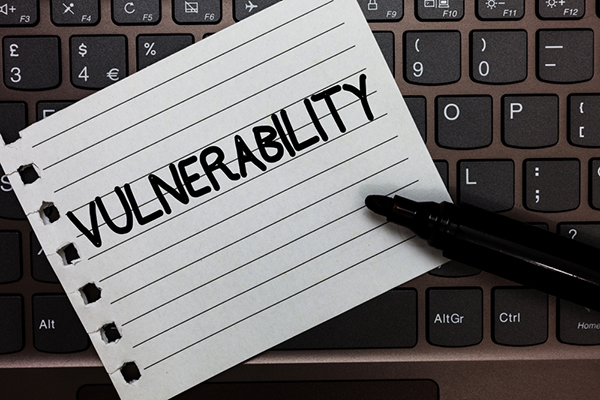
The story that we tell ourselves is usually what trip us up the most. The other thing that I often do with people in these kinds of situations is, what would you tell your best friend about this process that you’re going through? Bring that same compassion to yourself. We often don’t do that. We oftentimes have a much greater capacity to be compassionate, understanding, and supportive of others. We don’t always bring those same qualities to our own situations. Leaning into the discomfort and knowing, “Maybe this is going to be a colossal failure.” I’ve told all of my friends, not my inner circle of friends that, “I’m moving to another country and I might be back in six months,” or whatever the exposure is. The exposure is what happens if it doesn’t go the way I expect it to go. My answer is always, “Tell me what you learned from that. What do you gain from this experience? What’s the feedback? How do you use this to move forward and bring that same compassion that you would to somebody else or to a friend?” Does that answer your question?
It does totally. I love the thought about, what would you tell a friend? That tells yourself, “You better think through that.”
We put ourselves down so much. We’re like, “Shit, that didn’t work.” Even with Peggy in this show, I’m feeling vulnerable. I told about my couple’s therapy that not everyone will talk about it, but I’m being vulnerable because I want to help people. I learned so much from you and I’m hoping others will as well. Thank you, Alyssa.
Thank you so much, Peggy.
Dena has some questions about what’s going on with COVID. When this episode comes out, we’re hoping that people will be back at work. Nonetheless, it doesn’t matter. Even if we’re still dealing with other things in our lives especially with what’s going on. Dena, would you like to join us to talk about your question and your concerns?
I don’t seem to get that anxious by obsessing on the news. When the pandemic happened, I knew there was a time after a week or two that I had to take a break and I’d watch it once a day. I have been glued to CNN. I have friends in New York, in LA and everywhere. They’re all in these major cities where all of this is happening. I don’t know what to say to my kids. I don’t know how to make good of it or see that or do any of it. I’m saddened by all of it.
We all need help with that. What do you think, Peggy?
I believe that in some ways my response would be the same to both of those questions, whether it’s the pandemic or the rioting. In that, this is such a universal experience in our country and we’re all experiencing it. Even as a therapist, people are coming to me talking about their fears of the pandemic. I’m in a vulnerable age group. I have those same fears. I can’t pretend that I don’t nor would I think it would be wise to do that. The same thing applies here to both the pandemic, having to be inside and stay at home, the possibility of re-entry, and layer on top of it, all of this violence and injustice that started all of this. The conversation has to be first about affirming their fears and also about, I too am afraid. As parents, our tendency is to protect our kids from those kinds of fears.
An affirmation of, this is a frightening time on many levels and it’s layered with different things for different families and different organizations. My response is what we have to do first is affirm how our kids are feeling and answer their questions openly. I’ve talked to many parents over the last several days. It’s a painful time. It’s difficult to hold this space with people, especially people of color or other marginalized groups. Every time there’s one of these incidences, it’s in waves of PTSD. They surge and it all comes back. What most of us know is that this is not new. This is centuries old and we want to believe that we’re doing better. It’s hard to talk about the remedies because they’re not there.
Politically, we’re probably in a much more frightening space than we’ve ever been, in my opinion. There’s a lot coming at kids. There’s a lot of misinformation. There’s a lot of prejudice. There’s a lot of racism, veiled as it might be. First and foremost, it’s be open to having those difficult conversations about your fears, about the ways that you want to protect them. Affirming them is first and foremost. That connection is what they need. They don’t need to be told, “Don’t worry, it will be okay. We’re not in the city. We’re on the outskirts of the city,” or whatever it is. It’s real. It’s in everybody’s faces. I don’t know how old your children are, but most children have access to television or phones or iPads.
We need to acknowledge our vulnerabilities, befriend our nervous systems, give it a name, and get curious about our emotions. Share on XWe’re inundated with these images or newspaper is thrown on your front porch. There are the images there. There’s no escaping it. To be able to talk to them about we want to limit our exposure while we’re taking this all in, so that it’s not overwhelming, but that your fears are real. I don’t think you have to pretend to have answers. That’s where we get stuck as parents. Oftentimes it feels like in order for me to protect my child, I have to tell them that this is what I’m doing. This is what somebody else is doing and it’s all going to be okay. That’s a disservice to our children, no matter how old they are. The conversation we have, we want it to be age-appropriate and to help them understand. For much younger children, it’s important to limit their exposure even more so than older kids, but to help even older kids understand that our nervous systems can only handle so much.
As individuals, we can start to make a change. That’s what this is about. All of this protesting that unfortunately has turned into violence in many areas is the demand for change. What are some ways that we as individuals can begin to look at this? It’s not so much as this is what’s happening to people of color or other marginalized groups, but this is what’s happening to our neighbors. This is what’s happening to our communities. This is what is happening to all of us. What are some steps that we as individuals can begin to take to affect some change? That’s a long and arduous process. The short answer is affirming their fears and helping them to have a voice and express those fears and not shushing them or telling them don’t worry about it.
It’s interesting you say that because my eighteen-year-old was like, “Is everything going to be okay, mom?” I said, “Yes, it’s going to be okay.” An hour later she said, “Mom, it’s not going to be okay.” It was like I was lying to her. I don’t have the answers. I said, “What should we do about it?” She started to tell me all the things that we could do by posting things and what can we do. She knew the answers better than I did. I was trying to gloss it over and say, “It’s going to be okay,” but I don’t know that it is. I do agree with being real.
It’s a natural response as a parent though. What we want to do is protect our kids.
Are you doing that too, Dena? Are you like, “It’s okay, don’t worry?”
No. As we’re all in the house together, I said to my husband, “I feel like we need to.” I don’t have any of the expertise that Peggy does and I hope it wasn’t terribly detrimental. We sat down and watched CNN and we had a conversation. To your point, Karen, all three of my kids were doing and had been activists in ways that I didn’t realize they were doing. It was actually me who needed the education. I’m not looking at this white privilege as something that isn’t and being a voice for those that aren’t of white privilege. My kids were doing that already in their day-to-day lives.
I was a little bit relieved to see that they’re growing up in this world, that they’re being this participant for this change. They’re young. They’re not there yet. They’re a little bit behind. My littlest one was a little bit confused, but that was appropriate. They were involved. They were involved naturally with their friend groups or associations that they’re in or the charitable work that they do or service work, which I felt was somewhat my job. I wanted to make sure that I was putting kids out into this world that could make change.
You were affirming their feelings.
They weren’t coming to me. I put it in front of them. I was like, “We’ve got to talk about this.”
I’m glad you raised the issue of how confusing it was too, especially for the younger ones, because it is confusing. Police are supposed to be people that protect us. This is like many other arenas in our lives where people that are supposed to be protecting us, whether they’re policemen, priests, politicians, whomever, and then violate that trust. It’s clearly not everyone in those categories. That’s what gets confusing especially to younger children. That’s a good conversation to have with them. Because these policemen and the three others that were with him did this horrific thing, does not make all policemen bad.
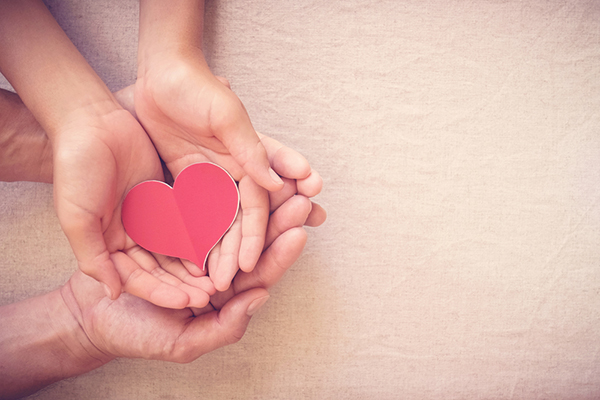
It is confusing for kids because they’re like, “Police? We’re supposed to be safe around them. They’re supposed to be keeping our communities safe.” To answer the questions about the confusion and notice that it is confusing and affirming it, “I’m confused by this sometimes too.” Affirming kid’s expressions and digging in a little deeper with them, “What happens when you feel confused.” Invite them to talk about those things. You did exactly the right thing. We’re going to watch this together so that we can talk about what we’re seeing, so that we can understand what’s going on in our world. We will try to sort out all this confusion together.
Rachel, I know you have some questions too about vulnerability and fear.
In this time of Corona, when you’re outside, people have their mask on, sunglasses on, and hats on. There’s this fear of engagement at all. You don’t want anyone’s breath to be on you. I feel like the reality is people have been incredibly shut off long before Corona happened. People are on their phones all the time in public. No one’s looking around and engaging. I have a dog and people don’t even make eye contact as you’re walking down the sidewalk. I happen to be someone who says hello to every single person I see, whether they’re looking at me with their headphones.
I just like to connect. I’m happy to be that person in life but I am so scared of people never engaging again. I’m wondering what you would say, as a population, a community, a culture, what is the importance of engagement? What does it do for you? The fear keeps increasing. It seems like everyday interactions like saying hello or even making eye contact with people. What would you say to get people to re-engage again and care about their community, their neighbors, and the strangers around them? What advice do you have for people?
I would answer that question a little bit differently in the middle of a pandemic than I would otherwise. In general, connection is a biological imperative. We are wired for connection. It’s what we want as humans. What happens to our nervous systems when we are getting all these cues of threat and danger is that we go into a more sympathetic state, which is a more fight or flight state. When we are in that state, we are now primarily wired for protection, not connection. It’s when we’re in a state of what is in Polyvagal Theory called ventral, which is safety and social engagement, then our priority is connection. As soon as our nervous system picks up cues of threat or danger collectively, like a lot of people’s nervous systems are picking up on right now, the priority is protection.
When you talk about, you don’t want to have that person sneeze on you or your going to move 12 feet this way when somebody comes walking toward you, in this time and space, that’s probably an appropriate response. I am somebody like yourself. I say hello to everybody I pass, whether I have a mask on or I don’t. I tell the person at the checkout, “I’m actually smiling at you and thank you for working.” It comes down to as individuals as we start and when that re-entry does start, which none of us know for sure when that’s going to be, that we respect that this is going to be a different experience for each of us.
As far as your fear of people never wanting to re-engage, I don’t believe that it is likely going to be the case. If anything, one of the silver linings in this may be that it helps people to get re-engaged. To your point, Rachel, before this all happened, people were on their cell phones. They were on screens of some kind and not engaging. I would go to a restaurant and see a family and everybody’s on some different screen. It is the case, especially because it’s convenient. It keeps little kids occupied. What it comes down to whether it’s re-entering from this pandemic or in general. Each one of us is having to make a conscious decision that we have lived in such a fast-paced world where we don’t even look at each other when we’re passing, let alone say hello or smile. Everybody’s on their path to the next thing that has to get done. In some ways, the imposed slowdown that the pandemic has resulted in for some people, not everybody, it begins to allow people to understand they don’t have to move at that pace. We don’t need all those things we thought we needed. We don’t have to go right from our office to Target or to whatever. We can slow down.
My hope is that collectively there is a slowing down, but what we have to also understand is that in the midst of this re-entry, there’s also this eagerness to get back to work, to get the economy back flowing. People might rush into things at a quicker clip. In general, it does come down to how are we each going to handle re-entry? What is the energy we want to bring to it? The other thing that happens between you and me, between Karen and me, between the three of us, is our nervous systems are always co-regulating. My job in particular as a clinician is to show up in a session in a regulated state. I want to help regulate the people that are coming in to see me. If I’m not regulated, my clients are going to notice that. If I’m not, for some reason, I’m going to talk about that.
One of the examples I give is if I have back-to-back sessions and maybe one was particularly challenging or maybe even threatening in some ways to my nervous system. People get loud and boisterous or angry or whatever. I have to regroup and navigate that energy in the room. When that session is over and somebody else is sitting out in my waiting room, I will typically go out and say, “I need a few minutes. I’ll be right with you. I appreciate your patience,” because I need to bring my system back to a state of regulation in order to be present to that next person. If we can think about that collectively as a society, everybody’s going to be re-entering with a certain amount of fear and the sympathetic energy, which is about protecting ourselves. It’s not about connecting. If we can be mindful of the fact that we can bring some of that connecting energy by simply saying, “I know this is scary,” or “This might feel a little awkward. I’m not sure how I should handle walking past you in the hallway,” or whatever it is. It’s naming it, instead of trying to guess at what other people are thinking because this is all new to everybody. What are your fears specifically about people are never going to want to re-engage? Is it based on your own fears about re-entry?
It’s been a fear of mine for a while in society. You were talking about the kids on like you now see even moms with kids in strollers and they have their iPads. There’s a lack of engagement. The stories about the YouTube live and horrible things are happening, and crowds are watching and they’re unaffected. It’s like almost real life isn’t happening. They’re not present. They’re not in the moment. I feel like Corona is exacerbating that feeling. How as a society are we going to come back with the core of what we’re talking about, vulnerability and compassion? How is society going to remember that compassion? There have been a lot of beautiful examples during this period too. I don’t want to say it’s all bleak, but I just feel like when you look at the microcosms of your life, it’s lacking.
Embracing the emotional exposures...the experience will be the teacher. Share on XIt’s an important point that you make. When you look at the microcosms, your own family system or your neighborhood or whatever, that’s where we have to begin this whole re-entry process. We have to bring compassion to it and understanding and patience. None of us have ever been through this before. Various people have different vulnerabilities. I’m significantly older than both of you. One of you might have an immune-compromised system. You’ve had health struggles in the past, Karen. We have to go into it knowing that not everybody is going to do it the same way that we think they should do it. Not everybody’s going to do it in a uniform way. Some people are going to be reckless about it even. This is a time that requires us to be brave and say, “I’m not comfortable with you coming that close,” or “I noticed you don’t have a mask on and I would appreciate if you would put one on.” Whatever it is that we’re all going to be noticing and paying attention to. What’s coming up for me as I walk into and re-enter this space that I used to not give a second thought to?
Honor what you need in order for your system to feel safe. It starts with each one of us as an individual. We can then talk to our families about re-entry, being compassionate, being understanding, first and foremost, being okay with saying, “This is not okay with me. I’m not comfortable with that,” whatever that is. We’re not wired that way necessarily. We’re a polite culture in general. We have these feelings, but we don’t say it, especially in the workplace, or where there are acquaintances versus close friends that we’d probably feel a lot more comfortable saying, “What’s wrong with you? Put a mask on.” We have to work that muscle to be able to have a voice about what we’re comfortable with and what we’re not and not worry about if somebody else thinks that’s nuts. It’s part of what we have to do.
When I talk about grateful goddesses, our inner self and our inner goddess, it’s like tapping into that inner goddess with courage and bravery and acknowledging, naming, communicating. It’s scary to do that though. I told someone to lift them. I said it in a way like, “I want to let you know that your mask is not covering your nose. I want to protect you. Can you please raise your mask?” The person took offense to it and walked away. It’s fine but I didn’t feel comfortable, but I do believe it’s important to be brave and communicate those things. Does that help, Rachel?
It does, thank you so much.
I know that Alyssa had a question that I wouldn’t mind bringing her back on. It was about her family and her dad that passed away. I feel like this is important that with our fears and anxieties, we think about something that might happen to us. For me, I’m on watch and wait. Every year I go through blood work and I’m always anxious. April 1st, I go for my blood work. I’m like, “My cancer is coming back.” Once I get past those, it’s like, “I’m cancer-free,” but there’s always something that we’re thinking about that might happen. I know, Alyssa, you specifically have a question about this that’s related to your family that I know you wanted to ask Peggy. I wanted to make sure you asked it.
Like you, Karen, we all have our fears and anxieties. Sometimes they’re rational and sometimes they’re irrational. In my case and yours, Karen, it was based on something that happened to us. My dad passed away years ago from Alzheimer’s disease and complications that ensued from it. He lived a hard last few years of his life. It was difficult. If not more difficult for him, it was more difficult for the family and his loved ones to watch what was happening with him. Some writer said, “It’s the long goodbye.” It’s the hardest thing that I’ve ever gone through my life. My father’s father passed away from Alzheimer’s as well. I’m the next generation. I feel like I’m next on the list. I’m getting to that point. I’m not quite there yet where they were when they had initial signs of the disease.
We all have our senior moments but for me, I get anxious about them. It’s like you see somebody on the street and you’re like, “What’s her name?” My husband sometimes has to be my wingman if I’m at a party. I’m like, “Quick, we met them.” Usually, he’s pretty good about bailing me out but it scares me. My question is, how do you put that aside? There are some things you have to disconnect from and almost like put on a shelf. For me, I feel like it’s always there. It’s a real fear. It’s not irrational. There’s a good chance this is my future. It’s debilitating. I don’t know what do you say to people like me who have that one thing. It’s out there. There’s nothing you can do, but it’s constantly right there sitting on your shoulder weighing you down.
First of all, I’m sorry that you went through that with your dad. My mom died too of Alzheimer’s and I know that path. That journey is extraordinarily painful. It is the long goodbye. That’s an understatement. One of the first things I want to invite you to do though is to try to be mindful of not judging the feeling that you have. Even when you first started to ask the question, you said, “There are rational fears and there are irrational fears.” That’s a judgment. Some fears are okay, some fears are not. I understand intellectually what the distinction you’re making but to me, language is extremely important. To begin to be conscious about the ways that you’re judging the feelings that you have and to make a conscious effort not to judge them as anything, just notice them and get curious about them.
You and I have a similar fear that it’s there. This is a genetic disease and you and I are genetically predisposed to this disease. It can be debilitating if that fear begins to own us. I want to be clear to my point was not necessarily to put something away but to place it on the bookshelf for a little bit, come back and pick it up and bring some other energy into it. The same thing would be true of the fears that we live with about, what if I’m next? Like you said, those senior moments. There’s almost a panic that sets in that, “This is it. This is the beginning of it.”
The reality is that we cannot control that. We don’t know if we’re going to have it. We can’t control it. There are some tests that can be done. There’s more cutting-edge work being done on Alzheimer’s and trying to find the genetic markers that would make us more vulnerable and things that can be done, but that’s a work in process. It doesn’t bring a lot of comfort to those of us who are pushing toward the point in our lives where that could become a reality. The thing to do is to bring compassion to that fear. It’s a real fear. There is the possibility that that happens. For myself, knowing that I can educate myself about it. I don’t know if you’re aware that Maria Shriver does a lot of work on Alzheimer’s in women in particular. She’s got a lot of good resources for me. Educating myself about something is always a way to lessen my fear about it.
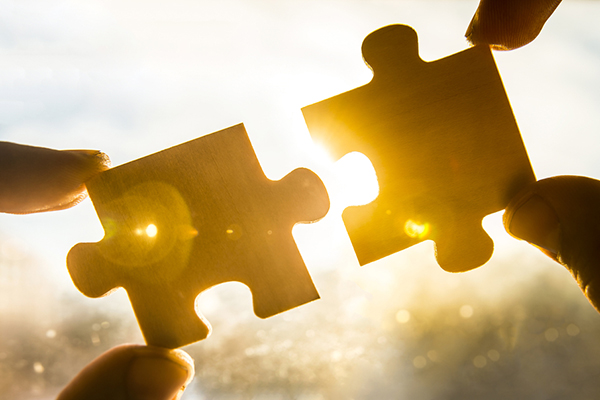
It doesn’t mean it’s going to go away because even if I’m well-versed on what happens, I saw it firsthand. All the education about it in the world is not going to prevent me from having it, but it will help me to understand what’s going to happen as it begins perhaps. I talked to my kids about it. I talked to my siblings about it. Oftentimes it is something that happens and we, the individual who might be inflicted with it, is not aware. I’ve talked to my family about it. I want to be made aware that something’s going on, that you’re noticing that I’m telling you the same story four times within ten minutes or however it might manifest. I can start to take some action and move toward getting as much support as possible, depending on what’s available at the time that it may or may not happen.
The other thing is that point specifically, it may or may not happen. We have to make conscious decisions about, “Do I want to be owned by this fear or do I want to notice that the fear is there, that it’s real, that it is a possibility and hold the space for there is also the possibility that I don’t get it?” It’s both ends that’s hard for most of us humans to embrace. There is the possibility that I will get it and there is a possibility that I won’t. How do I hold that space with compassion for that fear, but making conscious decisions about, “Do I want this fear to own me?” Sometimes it’s not even a question of do I want it to own me. I’m noticing it does own me.
I then have to bring other energy into it so that I can relax a little bit. For me, that’s in the form of educating myself, it’s in the form of asking others to give me feedback if they notice any changes. I talked to my physician about it pretty regularly. When there is more specific testing available, I’m first in line. I would rather know that I’ve got those markers and then it’s likely that it’s going to happen than sit and wait in fear, and then look at what my options are. It’s a real fear. I felt like I lost my mom ten years before she died. It’s a grieving process that is extraordinary.
My mom, who was vivacious, well-read, could talk about politics, sports and anything, became the shell of a person. One thing I will add to this is that part of my experience with my mom’s illness is if there was a gift in it. My mom in particular was not a good, loving, nurturing mother. She did not have that in her. She was a difficult person to be around and large and in charge. The irony was that I’m from a big family. I’ve got five siblings, I’ve got hundreds of cousins. All of them loved her and thought she was the Auntie Mame. She was great. When she became ill and it was clear that she needed more help, I had to go on this journey of I’m one of two of us that lives in the same area.
I have to find a way to reconcile some of these challenging moments in history with my mom. How do I transcend that anger, confusion, resentment or whatever you want to call it and be available to her and be there, be present in an authentic way? For me, the gift in her illness was the work that I did to reconcile that and to come to very real terms with she had limitations. She was raised by parents that didn’t have a lot to offer her. That work became the gift of that struggle. The fear is real. That’s the important starting place and be gentle with it.
I’m going to put you all on the spot. I wanted to ask you all what is your takeaway from this episode? Think for a minute what is your takeaway from what you’ve learned from Peggy? What have you learned about yourself? It could be one word, one sentence. What do you feel? Who would like to go first, Dena?
There’s so much that I could say from the wisdom and the insight that Peggy offered us. As I will put my vulnerability out there. I’ve had therapy and there are lots of reasons and needs for it. I believe in it and to me, it’s like a massage. It’s something you do that makes you feel so much better. Peggy, I would see my therapist and every time she would come out to invite me into her session, she would say, “Can you give me a minute? I’m going to use the restroom.” I took a look when you said that. I thought for a minute how much you take in everyone else’s stuff and everyone else’s problem, and to regroup and set.
I appreciate your sharing that, Dena, because the other thing that I want to say is that I do take that time and space with another human being. I hold it as sacred. I do feel like it’s my responsibility to be as regulated as possible. There have been times when I’ve come back into the session even after taking a minute or two and have said, “You might notice that I am going to be a little bit off, but I had a difficult session. I am present to you now. I want you to be aware that it might take me another minute or two.” I’ve had the luxury of doing my own work so that I can make that transition from that more sympathetic fight or flight state to a more regulated state quicker. To your point, some sessions are tougher than others. I want my clients to know that first and foremost, I’m human like you guys that are sitting in front of me.
That’s you showing your vulnerability, but also showing your authenticity, which is what you want when you’re going to therapy. You want someone who’s going to be like that.
For me, in both questions that I asked you, Peggy. If I were to think about what I’m taking away, it’s having compassion for my fears, compassion for risks that I have not yet taken and would like to take. It’s recognizing it. Putting them aside, bringing them back out, but when you take a step back and look and say and try to understand, why it is you’re feeling that way? As you said, Karen, bringing it close and there are times to do that in times when you’re not so prepared to do that. Compassion for these feelings, for these sometimes difficult feelings we’re having. That’s for me a big takeaway.
We all have the capacity to be compassionate and understanding of others, but we don't always afford or gift ourselves with that. Share on XThank you. How about Rachel?
I’m going to add on to that notion of compassion, because on the flip side of that is judgment and it’s easy. We all have our own lens and to judge other’s interactions and you don’t know what their lens is and you don’t know what they’re coming from. You don’t know what’s brought them there. For me being a highly extroverted person, it’s easy to judge introverted people to be like, “Why can’t you engage more? Why don’t you smile more? Why don’t you talk more?” You gave me a good reminder that we are all experiencing this differently. There are many factors that you can’t even count. Going back to the looting and the rioting and these conversations with my kids, yes, it’s awful that they’re doing this. I’m so sad for our city and we’re all fearing for our safety, but this is generations of feeling diminished and compromised. It’s like tinder. They’re fueled. We’ve all been bottled up. We’re also angry about this lifestyle and situation that it’s almost an excuse to erupt. It was like trying to also teach compassion to our children about what’s happening.
My takeaway is I’m going to circle back to the beginning. I love The Wizard of Oz. I bring that up a lot because I do relate to Dorothy and finding her way home. With this topic of vulnerability and courage, it reminds me of the Lion and how he searched and searched for courage. He wanted it from the Wizard that said, “You had it all along.” I feel like we have it all inside of us. It’s just, how are we going to express it? What are we going to do to nurture that? I know what you’ve shared with us has been ways of nurturing that inner goddess and that courage that’s inside of us. Thank you so much, Peggy, for joining us on this vulnerability fear and now transforming into courage episode.
Thank you for having me. I appreciate the conversation. These are important conversations. I appreciate hearing what each of you was able to take away from this. I love that it includes this idea of we all have the capacity to be compassionate and understanding of others, but we don’t always afford that or gift ourselves with that. We all need to be more mindful of that. We all have different experiences. We’ve all been on different journeys and some of us are more vulnerable than others to certain fears. If we can go into the world with compassion towards self, then it’s going to spread to others. Thank you for your thoughtful questions too. I appreciate it.
Peggy, if our readers want to contact you, how can they do that?
I have a website, which is PeggyHough.com. They’re welcome to contact me through that. There’s an email within the website. Thank you again for having me, Karen. I appreciate it.
Thank you.
—
We always do these favorite things. I want to talk about this because I feel it’s important to talk about our favorite things to bring joy or comfort or that kind of thing to us. I will start. Here we are talking about our favorite things. Either things that bring us joy and comfort. We were talking about vulnerability and fear on this episode, and I actually brought along a photo of me when I was alone. I am about three. This was when I was scared of what was under my bed. I have this photo beside my nightstand. I look at it all the time before I go to sleep and when I wake up. I tell myself, “You are okay.” I’m a mother now and I look at me when I was three, and I say, “You are okay. There’s no monster under your bed. You’re going to be okay.” I feel it. That’s what I do and that’s one of my favorite things. It’s my inner child and now I’m the mother and I know how to mother. I know, how to care and nurture. I take care of this little girl that had the crazy hairstyle. Rachel, what is one of your favorite things?
I’ve been wearing this necklace. I wear it all the time. It’s a lotus flower. The lotus is a flower that blooms from mud. It comes from this murky and ugly place and then it blooms this beautiful flower. I keep it close to my heart. One of my best friends, Lisa Kendall, it’s from her jewelry collection. It feels good.
I don’t know if it’s quarantine or not, but I have been feeling dry and chapped, and this is filled with peppermint oil and yumminess. It’s like a luxurious chapstick. This makes me feel happy when I’m feeling stuck inside.
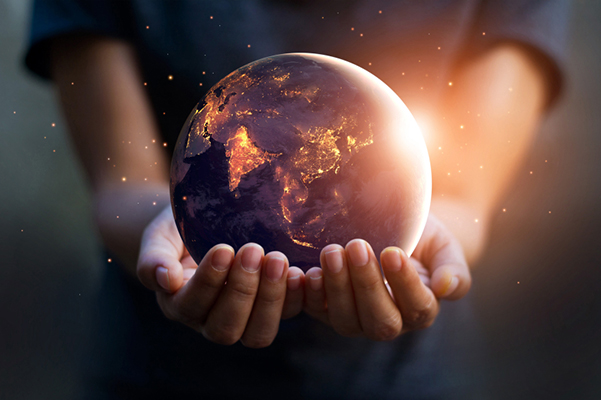
When we all go back to traveling around, this has been one of my favorite things pre-pandemic, and everyone in my family made fun of me when I used it. All of a sudden, I’m the hero with it. It’s called a fly caddy and what this does, and this is the craziest thing, but this goes over the tray table. It has these little pockets and I put my phone in one and my water bottle in the other. This goes over and then it pops back up. You have these pockets for your devices and whatever. You just wash it and use it on the next one. I travel with it and all of a sudden, my husband is not making fun of me anymore.
It not only makes you feel good, but it makes you feel safe.
It keeps everything organized to feel safe and clean.
I asked Peggy too to share. She’s new to this favorite thing. What did you bring besides your cute little dog?
That was actually one of my favorite things but now he has left. When you sent me the text, I decided this is where I was going to set up to do my session because my family’s behind me and just that we’re not always together. Some of them live out of town. It’s just the images of those that I love. I have pictures all around and that brings me great joy. It’s a way of connecting with them even when I can’t be with them. I tell people all the time that when I see my cell phone ring and it’s FaceTime with my son. It’s instant joy because I know my son is not going to FaceTime me, because he’s two and a half years old. Those are the things that bring me joy. My dog is my constant companion and he does bring me tremendous joy.
Thank you for sharing. Thank you for staying on for Favorite Things.
Important Links
- Peggy Hough
- www.PeggyHough.com
- @Lisa.Kendall.Designs – Instagram
- Ogee.com
About Peggy Hough
 Peggy Hough is a Licensed Clinical Professional Counselor specializing in the treatment of addictive disorders and trauma. She is trained in Somatic Experiencing (a trauma model developed by Peter Levine) and is a Polyvagal Informed practitioner. Polyvagal Theory developed by Dr. Stephen Porges, offers a way to understand the human autonomic nervous system. Deb Dana, LCSW, is responsible for translating Dr. Porges’ theory into clinical application. Peggy has studied PVT with Deb Dana and has assisted her in teaching the basics of PVT. Peggy is also a Master’s Level NLP clinician (Neuro Linguistic Programming), which is an approach to communication, personal development and psychotherapy. She also has studied with Pia Mellody and is a certified PIT clinician (Post Induction Therapy.) The premise of PIT is that childhood trauma is the origin of developmental immaturity, also known as codependency.
Peggy Hough is a Licensed Clinical Professional Counselor specializing in the treatment of addictive disorders and trauma. She is trained in Somatic Experiencing (a trauma model developed by Peter Levine) and is a Polyvagal Informed practitioner. Polyvagal Theory developed by Dr. Stephen Porges, offers a way to understand the human autonomic nervous system. Deb Dana, LCSW, is responsible for translating Dr. Porges’ theory into clinical application. Peggy has studied PVT with Deb Dana and has assisted her in teaching the basics of PVT. Peggy is also a Master’s Level NLP clinician (Neuro Linguistic Programming), which is an approach to communication, personal development and psychotherapy. She also has studied with Pia Mellody and is a certified PIT clinician (Post Induction Therapy.) The premise of PIT is that childhood trauma is the origin of developmental immaturity, also known as codependency.
In addition to her direct clinical work, which includes working with individuals, couples, and families, Peggy works with family owned businesses coaching them to achieve effective communication, conflict resolution, and understanding family systems and its role in family owned businesses. She conducts clinical trainings as well. Teaching is one of her passions and believes the therapeutic relationship is a great teaching platform in addition to classrooms and conferences.
